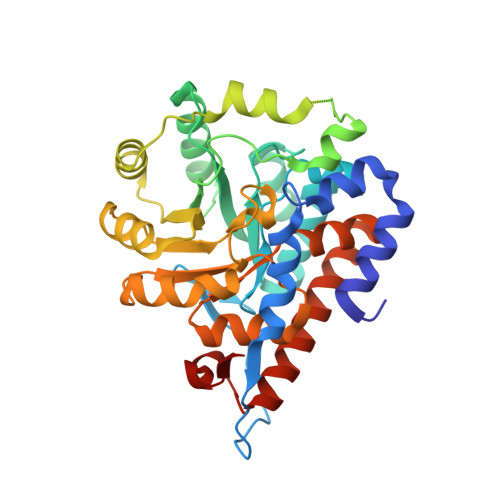Structure of Human Glycolate Oxidase in Complex with the Inhibitor 4-Carboxy-5-[(4-Chlorophenyl)Sulfanyl]-1,2,3-Thiadiazole.
Bourhis, J.M., Vignaud, C., Pietrancosta, N., Gueritte, F., Guenard, D., Lederer, F., Lindqvist, Y.(2009) Acta Crystallogr Sect F Struct Biol Cryst Commun 65: 1246
- PubMed: 20054120
- DOI: https://doi.org/10.1107/S1744309109041670
- Primary Citation of Related Structures:
2W0U - PubMed Abstract:
Glycolate oxidase, a peroxisomal flavoenzyme, generates glyoxylate at the expense of oxygen. When the normal metabolism of glyoxylate is impaired by the mutations that are responsible for the genetic diseases hyperoxaluria types 1 and 2, glyoxylate yields oxalate, which forms insoluble calcium deposits, particularly in the kidneys. Glycolate oxidase could thus be an interesting therapeutic target. The crystal structure of human glycolate oxidase (hGOX) in complex with 4-carboxy-5-[(4-chlorophenyl)sulfanyl]-1,2,3-thiadiazole (CCPST) has been determined at 2.8 A resolution. The inhibitor heteroatoms interact with five active-site residues that have been implicated in catalysis in homologous flavodehydrogenases of L-2-hydroxy acids. In addition, the chlorophenyl substituent is surrounded by nonconserved hydrophobic residues. The present study highlights the role of mobility in ligand binding by glycolate oxidase. In addition, it pinpoints several structural differences between members of the highly conserved family of flavodehydrogenases of L-2-hydroxy acids.
- Department of Medical Biochemistry and Biophysics, Karolinska Institutet, S-171 77 Stockholm, Sweden.
Organizational Affiliation:


















